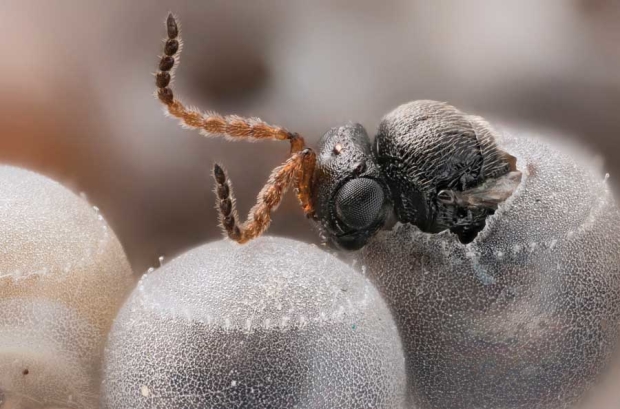
Trissolcus japonicus parasitoid wasp emerging from brown marmorated stink bug eggs at the USDA-APHIS Quarantine Facility, Corvallis, Oregon on Dec. 4, 2015. (Photo illustration courtesy Christopher Hedstrom)
If brown marmorated stinkbugs have emotions, they must be terrified of a baby killer named Trissolcus japonicus.
Growers might be fine with that given the threat posed by brown marmorated stinkbugs (BMSB). These stinkbugs, which are not native to North America, are voracious eaters that damage fruit, vegetable and ornamental plants. They also reproduce well: The stinkbugs overwinter as adults and emerge in the spring to begin mating, and a single female can deposit hundreds of eggs in her lifetime.
A parasitic wasp, Trissolcus japonicus, could be the perfect weapon to defeat them.
About the size of a flea, T. japonicus visits stinkbug egg clusters, attracted by the scent left by glands on stinkbug feet. T. japonicus jabs its ovipositor, a tube-like organ, into stinkbug eggs and injects its own eggs.
The wasp’s larvae gain nourishment by eating baby stinkbugs before they hatch.
If this reminds you of the science fiction Alien movies, scientists agree. In the movies, the alien larvae consume their hosts from within and eventually burst out.
T. japonicus does something similar, which makes it a surprisingly efficient killer of stinkbugs.
“They’re pretty amazing creatures,” said Dr. Kim Alan Hoelmer, an entomologist and acting director of the U.S. Department of Agriculture Overseas Biological Control Laboratories.
He knows growers would be happy to see T. japonicas authorized as a stinkbug control, a step subject to federal review.
So far, tests of chemical controls have not been promising, in part because stinkbugs can overwinter in protected places and move in and out of orchards. (Read: “Stinkbug continues its spread,” from our December 15, 2015, issue.)
The T. japonicas lifecycle is correlated to stinkbugs, but the adult wasps can live independently for months just on water or flower nectar.
When a female T. japonicas finds a stinkbug egg mass, it deposits one of its eggs in each of the host eggs.
The emerging T. japonicas are just 1.5 millimeters long, so tiny that scientists need microscopes to examine body parts. Males develop faster than females and emerge first and wait for their mates.
When females emerge, the two mate, fertilizing the females, and off they go. “It’s a rather strange but fascinating life cycle,” Hoelmer said.
Scientists have not clocked the speed of their flight but T. japonicas has enough strength to make progress against wind. “These wasps are kind of muscle-bound,” he said.
Hoelmer’s interest in Trissolcus japonicus began after brown marmorated stinkbugs were discovered on the East Coast in the mid-1990s.
A Cornell University entomologist, Richard Hoebeke, in 2001 determined that BMSB had come from Asia.
BMSB has proven to be a much more severe pest than any of the stinkbugs native to the United States; annual damage to apple orchards alone is measured in the tens of millions of dollars, and BMSB is gaining territory.
In 2013, a Vancouver, Washington, apple grower documented the first known BSMB damage in the Pacific Northwest.
In Michigan, BMSB is now widespread. (See “Have you seen this stinkbug?” at right).
Since the brown bug came from China, Hoelmer and other researchers at several universities and agencies looked there to learn more about this stinkbug, including its natural predators.
Researchers found several species of parasitic wasps that kill stinkbug eggs, with T. japonicas by far the most lethal threat. T. japonicas kills up to 90 percent of stinkbug eggs, but does not sting or harm humans or pose a threat to other plants or animals.
Researchers in 2007 brought T. japonicas to the U.S. for study in quarantine labs. Federal laws seek to prevent the escape of insects under review for fear of harm to the environment.
In the labs, Hoelmer and others studied how T. japonicas lived, fed and died.
What did it eat? In China, T. japonicas primarily ate pest stinkbugs but not much was known about its appetite for non-pest species. In the USDA labs, researchers presented different stinkbugs to T. japonicas.
Almost always in the tests, T. japonicas preferred brown marmorated stinkbugs. That gave weight to the theory that T. japonicas could work as a natural BSMB control.
Then came a big surprise.
The research populations of T. japonicas were kept under tight controls but in 2014, some wasps were discovered in the wild, just outside of Washington, D.C., in a Maryland suburb.
No one knew how those wasps had entered the U.S., but the possibilities included arriving from Asia within stinkbug eggs laid on plant material on a cargo ship or hitchhiking on the clothing of a traveler.
This discovery caused a hunt for more T. japonicas, which was found in the district, northern Virginia and other parts of Maryland.
Then in October of last year, T. japonicas was found in two small clusters in Vancouver, Washington, by a field technician with Washington State University.
Researchers wondered if the T. japonicas found on both coasts were the same, but genetic analysis showed the two groups came from different populations and were unrelated to those under quarantine study, Hoelmer said. Clearly, T. japonicas is a savvy traveler.
These discoveries meant scientist are now studying T. japonicas on two tracks — those in quarantine and those in the wild.
Hoelmer said growers are hopeful that T. japonicas can be authorized as an agent to control brown marmorated stinkbugs.
However, that step requires a review and permitting process, and it’s unclear how long that would take. It’s possible, he adds, that T. japonicas itself may bypass the process simply by proliferating in the wild.
And isn’t that what happened in Alien? •
by O. Casey Corr






Leave A Comment